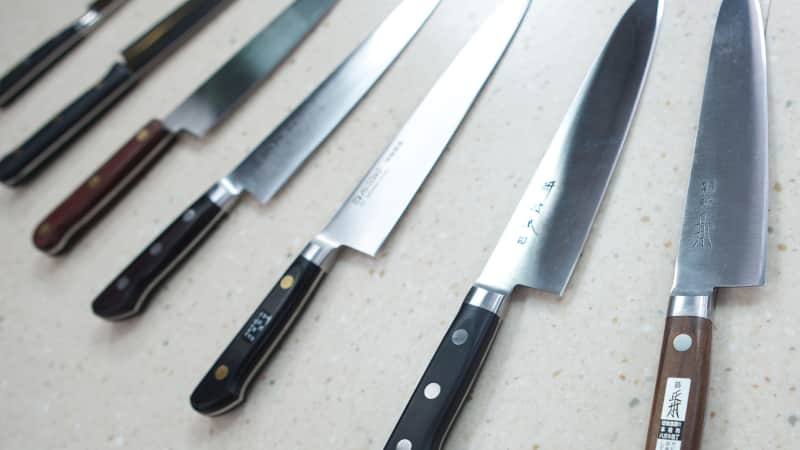The Best Chef’s Knives for $75 or Less
Equipment Review
Carbon-steel enthusiasts have long considered these knives sharper and more durable than stainless. But do they really perform better—and are they worth the upkeep?
Published Nov. 1, 2014. Appears in America's Test Kitchen TV Season 16: Roast Chicken and Potatoes Revisited

As serious cooks, we’ve always been intrigued by knives made from carbon steel. This alloy is considered superior to stainless steel by many chefs and knife enthusiasts because it is believed to be harder and stronger and able to take on—and retain—a keener edge. But as practical cooks, we’ve been a bit skeptical. Carbon steel is a high-maintenance metal that rusts if not kept dry, so the makers of carbon-steel knives recommend drying the blade immediately after washing it; some even suggest wiping the blade dry between cutting tasks or occasionally coating it with mineral oil to ward off excessive oxidation, which corrodes the metal. Given that our longtime favorite stainless-steel chef’s knife is virtually maintenance-free, that’s asking a lot.
Still, we wanted to know if carbon steel was truly a cut above stainless. We singled out eight carbon-steel chef’s knives, a mixture of Western- and Japanese-made blades, priced from $72.99 to a staggering $299.95. We recruited seven testers of various abilities to put the knives through our standard cutting tests: mincing parsley, dicing onions, quartering butternut squash, and butchering whole raw chickens. Before and after each round of tests, we sliced through sheets of copy paper; whether the blade cleaved smoothly or dragged indicated how well its edge held up. And all the while, we noted the overall user-friendliness of each model, particularly with regard to the handle.
Battle of the Blades
Some knives had sharp spines or handles that pressed painfully into our palms and caused fatigue. Better grips offered what ergonomists call “affordance”: a shape and texture that allow multiple grips, so hands of all sizes feel comfortable and secure.
As for the meat of our testing—the blade—we homed in on sharpness, which is determined by two factors. First, the thinness of the edge, which is measured by its V-shaped angle. Simply put, the narrower the angle, the cleaner and more precise the cuts. Our top-ranking knives, which were sharpened to between 10 and 15 degrees on either side of the blade, slid through food, while we had to use more force with wider blades that were sharpened to 20 (or more) degrees on either side.
The second determining factor, the strength of the metal, depends on the type of steel that’s used and how it is heat-treated. Manufacturers wouldn’t disclose this information but did share their blades’ Rockwell scale ratings—a measurement of the metal’s strength in a unit called HRC (HR stands for Hardness Rockwell, and strong metals like these are in the “C” class). Sure enough, the highest and lowest Rockwell ratings—60 and above, and as low as 52, respectively—co...

The mission of America’s Test Kitchen Reviews is to find the best equipment and ingredients for the home cook through rigorous, hands-on testing. We stand behind our winners so much that we even put our seal of approval on them.

This is a members' feature.